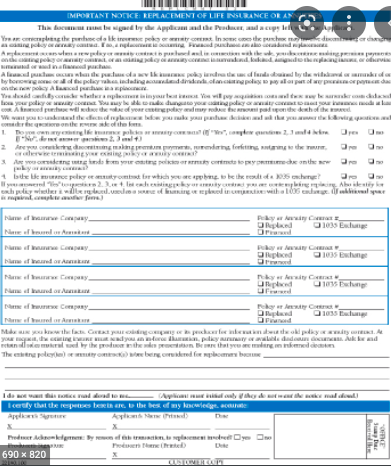Why is an applicant’s Signature required on a life insurance application?
Why is an applicant’s Signature required on a life insurance application? When an applicant signs their Signature on a life insurance application, it is meant to show that they are aware of the risks associated with the policy.
It is also a way for them to acknowledge that they have read and understood the terms and conditions of the policy.
Signatures are typically written in ink and scanned into a computer or digital document. This ensures that no one can claim that they did not know about their policy or did not understand its terms and conditions.
Signature on Life Insurance Statement
Life insurance policies are a contract between an individual and a life insurance company, which pays a lump sum of money in the event of the insured person’s death.
Life insurance is an investment to provide peace of mind and financial security in case of death. It is important to understand the difference between life insurance and term life insurance.
Term life insurance provides coverage for a fixed period, while permanent or whole life insurance covers your entire lifetime.
A Life Insurance Policy is a contract between an individual and a life insurance company, which pays a lump sum of money in the event of the insured person’s death.
Life insurance is an important financial tool that can provide peace of mind in unforeseen events. However, when filling out an application, an applicant may be reluctant to sign their life insurance policy without first knowing the benefits and risks.
Therefore, to ensure that the insurance company can get in touch with you if anything happens, you should always have your Signature on file.
Reason for the Signature on Life Insurance Policy
Life insurance applicants have to provide their Signature on the application. Signatures are required to prove the applicant’s identity and that they have read the terms and conditions of the life insurance contract before signing.
This is to prevent fraud from occurring and ensure that a policy proceeds with a payment provider.
Life Insurance Signature Requirements
Life insurance is a type of insurance that provides coverage for the risk of death.
It is a contract between an insurer and an individual or group of individuals, typically guaranteeing benefits to the insured if the insured dies.
The agreement can be either with an insurance company or with someone who writes their own contract.
Individuals can purchase life insurance for themselves, their children, or another person.
The amount of life insurance coverage available will depend on the age and health of the individual and other factors such as gender and occupation. In addition, coverage is typically provided for a specific period, which may be permanent or temporary.
Why is a Signature necessary?
Signature requirements for life insurance applications vary from company to company. This means that you will have to be careful in deciding which conditions are important and how they should be met.
The signature requirement includes the following details:
– Name of the applicant
– Date of birth
– Social Security number
– Address of residence
– Signature
History of Signature on Life Insurance Agreement
Signature requirement on life insurance applications is a common practice. It was introduced during the late 19th century. It was to prevent fraud and protect the insurance company from bad debtors.
Signature requirement on life insurance applications was first implemented in the United States in the late 1800s. The condition was meant to ensure that the applicant signed their application and did not have any other intentions of defrauding the insurer.
The requirement for a signature on legal documents is not new. However, the practice was not widespread until the early 20th century, when it became more common.
In 1885, the US Supreme Court ruled that a signature was necessary for a contract. In 1896, the US Congress passed an act requiring signatures on all contracts over $500.
In 1930, President Herbert Hoover signed an act requiring signatures on all government contracts over $5,000.
The insurance industry had to change its practices when it became mandatory for customers to sign a contract before buying insurance.
Before signing a contract, insurance was sold based on “honesty” and “trust.” Customers were expected to be honest about their health, and insurers were responsible for verifying that the customer was healthy.
Verifying that a customer was healthy involved many different steps, such as examining the customer’s teeth or other body parts. The process could take weeks or months, but it would generally happen before an insurer issued an insurance policy.
The process changed when contracts became mandatory, and customers had to sign them to buy insurance from an insurer.
With this change came a change in how insurers did business: they now only needed to verify that.
The law has since been revised and amended many times, but the signature requirement remains in place today.
Conclusion
A signature is a unique mark or symbol made by a person on an object. It’s a personal way of identifying the thing as belonging to the person. For example, the signature requirement for Life Insurance Applications means that the applicant must sign their application to be eligible for coverage.
There are two types of signatures:
1) Signature Required: An applicant must sign their application to be eligible for coverage. This Signature can be either handwritten or typed. It must appear on every page and at least once on each side of every page.
2) Signature Not Required: An applicant does not need to sign their application, but they must still provide all required information such as addresses and phone numbers.



